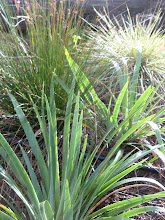 Yesterday, I worked on a new segment of the trail with my dad. Eventually, the trail will be a great loop through the property. We keep it simple, with dirt, logs, and leaf-litter mulch.
Yesterday, I worked on a new segment of the trail with my dad. Eventually, the trail will be a great loop through the property. We keep it simple, with dirt, logs, and leaf-litter mulch. 
While we were clearing the ground for the stairs above, I found this weird burly root. I don't know what it is.
1. Part of a redwood root system, since the trail was below a large redwood
2. Part of a root belonging to Marah oreganus, the Wild Cucumber, also called Coastal Manroot, because it's supposed to have a massive tuber. It also happens to be dormant this time of year and we do have tons of them on the property, so it's possible.
I put it in a pot, so we'll see what comes up.
There are many rewards for traveling down the new segment of the trail, including
mushrooms red as tomatos,
old alders in a skunk cabbage bog (cabbages dormant),


I won't be working on this trail again for some time. Today I followed my brother and his family back down to Woodland, to find my next step. The cab of my truck is loaded with the bare necessities and I'm on the quest to find a cool place to live and work while I think about graduate school or whatever's coming next. (It's going to be tough to garden without some land.) This week I'll be exploring Sacramento, San Francisco, Davis, and Woodland. If nothing feels right, I may head south. I'm going to wing it for a while.






























































